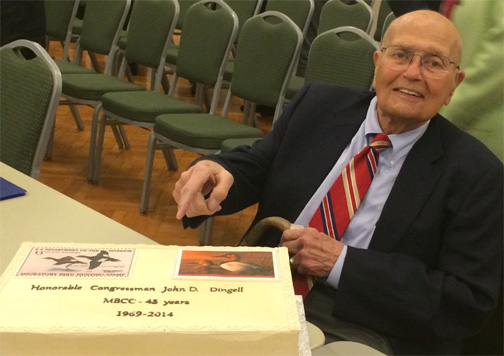by Alan Wentz
So, if someone were to tell you there is a group in Washington, DC, working for conservation with special focus on birds and federal lands and it has final approval over tens of millions of dollars (annually), approves buying and leasing all sorts of federal interests in land, mostly wetlands and grasslands, and is completely bipartisan in every way with rarely any dissension within its own ranks, or from Congress, or from the public, you’d think “alternative facts” – right?
Oh, and it has been quietly doing this since 1929 and has spent 100s of millions of dollars in the process and intends to continue doing the same thing forever, then what would you say? How about if I say the group includes members of Congress and the heads of federal agencies along with a rotating cast of state wildlife agencies and non-profit groups?
As avid readers of Wingtips and buyers of the Migratory Bird Hunting and Conservation Stamps (commonly known as Duck Stamps), most of you know that the mystery group is the Migratory Bird Conservation Commission. But I suspect you could ask the questions above of hundreds of people on the street or even from conservation agencies and organizations, including most Duck Stamp buyers, and only a minuscule percentage of those people would have any idea what you were talking about.Maybe that’s a good thing; flying below the radar is sometimes smart. On the other hand, knowledge is powerful, so let’s take a quick look at the Migratory Bird Conservation Commission.
Passage of the Migratory Bird Conservation Act in February 1929 created the Migratory Bird Conservation Commission. The Act allows the federal government to acquire and protect habitat for migratory birds. But it was the passage of the Migratory Bird Hunting Stamp Act in March 1934 that gave the Commission real clout and real purchasing power through stamp dollars. The Commission approves purchases of interests in land and water by the Fish and Wildlife Service. In addition to approving purchase and rental prices, it considers establishment of new National Wildlife Refuges and gives final approval to grants under the North American Wetlands Conservation Act (NAWCA).
Funds under the purview of the MBCC for acquisition of National Wildlife Refuges generally come from the Migratory Bird Conservation Fund. Sources of revenue for the Fund include Federal migratory bird hunting and conservation stamp sales (Federal Duck Stamps), appropriations from the Wetlands Loan Act, disposals of land, proceeds from right-of-way sales across refuges, refuge entrance fees, import duties on arms and ammunition, reverted Federal Aid funds, and sale of products. In practice, however, most of the funds today come through the Duck Stamp and import duties. In fiscal year 2016, collections amounted to more than $85 million. Over $76 million were obligated for expenditure and carry-over funds will be available for fiscal year 2017.
So, who makes all these important conservation decisions? The original statute defined the membership of the MBCC, and it still does with a few modifications since the act passed. Members include the Secretary of the Interior serving as the Chair, the Secretary of Agriculture, the Administrator of the Environmental Protection Agency, two U.S. Senators appointed by the President of the Senate, and two members of the U.S. House of Representatives selected by the Speaker of the House – traditionally the members of Congress are selected from the two dominant political parties to maintain a bipartisan membership. The head of the USFWS Division of Realty serves as Commission Secretary. In addition, ex-officio members from any states where land interests are to be acquired are invited to participate in the discussion and to vote on acquisitions in their state. After the MBCC was given the authority to approve project funding under NAWCA in 1989, the law requires that two members of the North American Wetlands Conservation Council also serve as ex-officio members to consider and vote on any projects submitted for MBCC approval.

It’s interesting to note that members of Congress who are appointed to the MBCC often are long-tenured. For instance, Congressman Silvio O. Conte (R-Massachusetts) served with enthusiasm for 25 years. But Congressman John Dingell (D-Michigan) served on the Commission for 45 years until his retirement from Congress – longer than any other appointee!
The Commission has regularly met three times a year in Washington DC for review and approval of fee-title and easement acquisitions, but the meetings are now usually held twice a year. Overall, the MBCC, through the Fund, has helped to grow 253 refuges, accounting for over 2,406,000 purchased acres and 136,000 leased acres. If you add to that those WPAs in the refuge system – the “mini-refuge” Waterfowl Production Areas mostly found in the Prairie Pothole Region – the numbers of acres are increased by more than 3.2 million acres, about two-thirds of which are grassland or wetland perpetual easements or leases.
The business of the MBCC is regularly published and a press release issued after each meeting. More details can be found on the amazing work of the Migratory Bird Conservation Commission in its annual reports on the U.S. Fish and Wildlife Service website under the Realty Archives. MBCC Reports for 2004 – 2016 report on each year’s activities in great detail.
Alan Wentz served as Chief Conservation Officer of Ducks Unlimited (now retired), is a past president of The Wildlife Society, and was formerly employed by the Kansas Department of Wildlife and Parks, the National Wildlife Federation, and South Dakota State University. He has written extensively on conservation with a special focus on wetlands.
A version of this article first appeared in the 28 April 2017 issue of Wingtips.